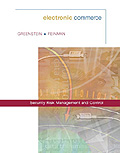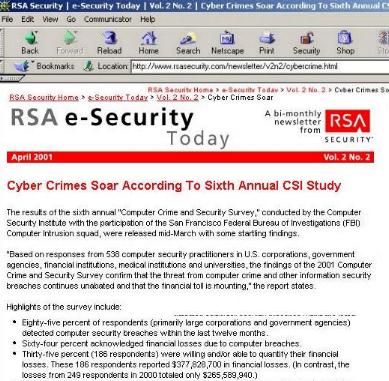
Chpt 7

Chpt 17
Chpt 19
Chpt 20
Chpt 24
| IEC 818 | SECTION 3 ©
RSA and Cyber Crimes growing Internet Security Standards Security Policies and Countermeasures Threat Modeling & Risk Assessment Tiger Teams Disaster Recovery Plans weak points Security Processes
-Hackers -Crackers The Human Factor Social Engineering After the attack Incident Handling and Hacker Exploits" |
changes last made to this
page 2001, May 3rd
In Section Three we will
use material from the following texts
 |
Chpt 6
Chpt 7 |
 |
Chpt 4
Chpt 17 Chpt 19 Chpt 20 Chpt 24 |
course author:Tim Richardson
.
| . | Learning Objectives
for Section 3
After completing this section participants will be able to
|

 |
Before we begin
this section, it is perhaps wise to pause and reflect on whether the precautions
we are about to discuss are necessary - that is to say "why deal with the
trouble of security procedures if the threat, in actuality, is not very
big?"
The answer to this question is a resounding YES - the threat is real and it is growing. We searched for an authoritative voice on threat trends and found the article below - this article discusses a survey conducted by the Computer Security Institute (a legitimate and credible organization) and the FBI's Computer Intrusion squad based in San Francisco. The survey concludes that cyber crimes are rising substantially - therefore the threat is real and it needs to be dealt with. |
| "The results
of the sixth annual [2001]"Computer Crime and Security Survey," conducted
by the Computer Security Institute with the participation of the San Francisco
Federal Bureau of Investigations (FBI) Computer Intrusion squad,
were released mid-March [2001] with some startling findings. "Based
on responses from 538 computer security practitioners in U.S. corporations,
government agencies, financial institutions, medical institutions
and universities, the findings of the 2001 Computer Crime and Security
Survey confirm that the threat from computer crime and other information
security breaches continues unabated and that the financial toll
is mounting," the report states."
www.rsasecurity.com/newsletter/v2n2/cybercrime.html |
 |
| . | After reading the story
in the RSA page about the Survey concluding Cyber Crime is growing, you
should pause and reflect if
1. Cyber Crime is growing, or is it also partly 2. Companies are simply getting better about detecting cyber crime. |
| Counter
measures Counter
|
Responding to a security
risk, or a threat of a security risk
http://www.witiger.com/ecommerce/SANwarning.htm
|
| Security
Considerations Proper
|
|
| Security
Considerations Proper
|
Security Procedures:
Weak Points
|
||||

Chpt 6 Risk Management
|
"Electronic Commerce":
Greenstein & Feinman, Chpt 6 Risk Management
Greenstein page 171 "Risk Management is a methodology for
|

Chpt 6 Culture
|
"Electronic Commerce":
Greenstein & Feinman, Chpt 6 Risk Management page 174
Culture Management
"Controls over the human factor are called social controls and managing these controls is called culture management. The human element of managing risk is the most troublesome aspect to many information technology professionals. The major risks of the human factor are
|

Chpt 6 Risk
|
"Electronic Commerce":
Greenstein & Feinman, Chpt 6 Risk Management page 176
Risk Management Paradigm
You should carefully review the pages from 176-178. The
key point is that
|
| Risk
Assessment |
Risk Assessment
"Most assessments today focus on the Web user interface, Web server setup, links to company databases, and server scripts. The checks should include planning of countermeasures regarding DDoS, defacement, and "hijacking" - the intrusion of a non-authorized third party into a two-party transaction, as recently occurred at nike.com, bali.com, and web.net, which were deprived of their virtual identities. Evaluate the ability of the security analyst to assess Web server setup vulnerabilities, in terms of administration privileges and software modules such as CGI, ASP, etc. This analysis is usually performed by a "tiger team," which may be made up of ex-crackers or reformed wayward university students. Or it may consist of properly trained security engineers."
"In every case, a security assessment service must provide an analysis of the effectiveness of a company's security controls. Global Integrity, for example, recommends a periodic assessment based on a review of current documentation, policies, and practices; interviews with key personnel; and comparisons against industry "best practices" and other benchmarks. A thorough review should not stop with the infrastructure. You also need to test your defenses against social engineering - the set of techniques used to subvert systems by exploiting human nature. One bank I studied paid no attention to managing the e-mail relationship with the system administrators. By spoofing an internal e-mail address, an intruder could contact bank employees with a request to "check the correct password," and 90 percent of the time they responded with the correct information without taking any steps to verify the sender's identity." |
|
Chpt 19 Threat Modeling
Chpt 19 Threat Modeling
|
Secrets
& Lies: Digital Security in a Networked World
by Bruce Schneier
Chpt 19 Threat Modeling
and Risk Assessment
"Threat modeling is the first step in any security solution. It's a way to make sense of the vulnerability landscape... It involves thinking about a system and imagining ... how you can attack this system". Risk Assessment
Chpt 19, page 301
Risk Assessment and Estimating Security Costs "Some risks have a very low probability of incidence. If the risk is a network intrusion by an industrial competitor out to steal the new design plans, the expected loss per incident might be $10 million but the number of incidents per year might be 0.0001 - there's a 0.1% chance of this happening per year. This means that the annual loss expectancy (ALE) is $10,000, and a countermeasure costing $25,000 isn't such a bargain". |

Chpt 6 Disaster
|
"Electronic Commerce":
Greenstein & Feinman, Chpt 6 Risk Management page 178
Disaster Recovery Plans You should carefully review the pages from 178 - 181. Good Planning involves considering the following objectives
|

Chpt 4 "Who"
"Who"
"Who"
|
Secrets
& Lies: Digital Security in a Networked World
by Bruce Schneier Chpt 4 Adversaries
Schneier begins the chapter by categorizing adversaries in several ways. Adversaries can be differentiated according to their
3. Resources. Adversaries can be categorized according to whether they have money, or know how, or ideally bothSchneier cautions "insiders are not necessarily employees. They can be consultants and contractors...". During the Y2K scare, many people with suspect expertise were given wide access to IT networks in hopes that they could fix the bugs in time.
A summary of the "participants" in the IT threat community
|

Chpt 4 "Hackers"
a subtle
|
Secrets
& Lies: Digital Security in a Networked World
by Bruce Schneier Chpt 4 Adversaries "The word Hacker has several definitions, ranging from a corporate system administrator adept enough to figure out how computers really work to an ethically inept teenage criminal... The word has been co-opted by the media and stripped of its meaning. It used to be a compliment, then it became an insult. Lately people use "cracker" for the bad guys and "hacker" for the good guys." Schneier page 43 "I define a hacker as an individual who experiments with the limitations of systems for intellectual curiosity or sheer pleasure; the word describes a person with a particular set of skills and not a particular set of morals" |

Chpt 17 The
|
Secrets
& Lies: Digital Security in a Networked World
by Bruce Schneier Chpt 17 The Human Factors
Schneier
"Information never stays in computers; it moves onto paper all the time. Information is information and, for an attacker, information in paper files is just as good as information in computer files. Many times paper in trash is more valuable than the same data in a computer: It's easier to steal and less likely to be missed. A company that encrypts all of its data on computers, but doesn't lock its file cabinets or shred its trash, is leaving itself open to attack." Human Weaknesses page 258
Social Engineering page 266-268 "Social Engineering is the hacker term for a con game: persuade the other person to do what you want". Schneier discusses various examples of social engineering over a few pages. It is a term that can be found throughout the web related to IT security situations. You could earn some class participation / contribution marks by finding some specific examples of social engineering used in some hacking situations, which have been reported on by the media, and make a summary of what happened, and email this to the professor running the course. |

Chpt 20 Security
|
Secrets
& Lies: Digital Security in a Networked World
by Bruce Schneier Chpt 20 Security Policies and Countermeasures Schneier
".. every organization needs a security policy for its computer network. The policy should outline
|
|
Chpt 24 Security
Chpt 24 Security
Chpt 24 Security
Chpt 24 Security
|
Secrets
& Lies: Digital Security in a Networked World
by Bruce Schneier
Chpt 24 Security Processes Following his axiom that security is a process, not a product, Schneier opens Chapter 24 saying that page 367
The Principles of the
Security Process which is presented by Schneier p. 367-374
|

Chpt 7
|
"Electronic Commerce":
Greenstein & Feinman, Chpt 7
The reason why you should cover Chpt 7, if you are not familiar with the content, is so that you know something about TCP/IP, IP addresses, FTP and the basics of messaging protocols on age 214. |
|
After the Attack |
"Cracking cybercrime
Don't touch electronic evidence until you call in the cops or a cyberforensics expert." is the title of an October
1998 article in Network World written by Deborah Radcliff
"Thou shalt not bungle computer
evidence intended for a court of law"
"Crimes committed via computer leave distinct evidence trails. If you so much as access, download or open suspect files, you could taint the evidence and render it inadmissible. That type of activity alters backup files and system logs and overwrites date and time stamps... Draft a contingency plan for when cybercrime strikes and take the proactive measures ... regularly print and save log files from critical servers. Establish a tamper-proof backup system to capture activity and audit trials."
|
 |
1. If asked to describe "from where threats come", could you answer with a list categorizing adversaries in five ways? 2. If you were challenged to give an specific example of how a hacker penetrated a system, could you provide one? Sometimes people know threats are a problem but they have an easier time believing it if you can provide a real example. 3. Could you explain to a non-IT person what a tiger team is and why you might need to use one? 4. Would you be able to speak about at least 5 of the Principles of the Security Process which is presented by Schneier |